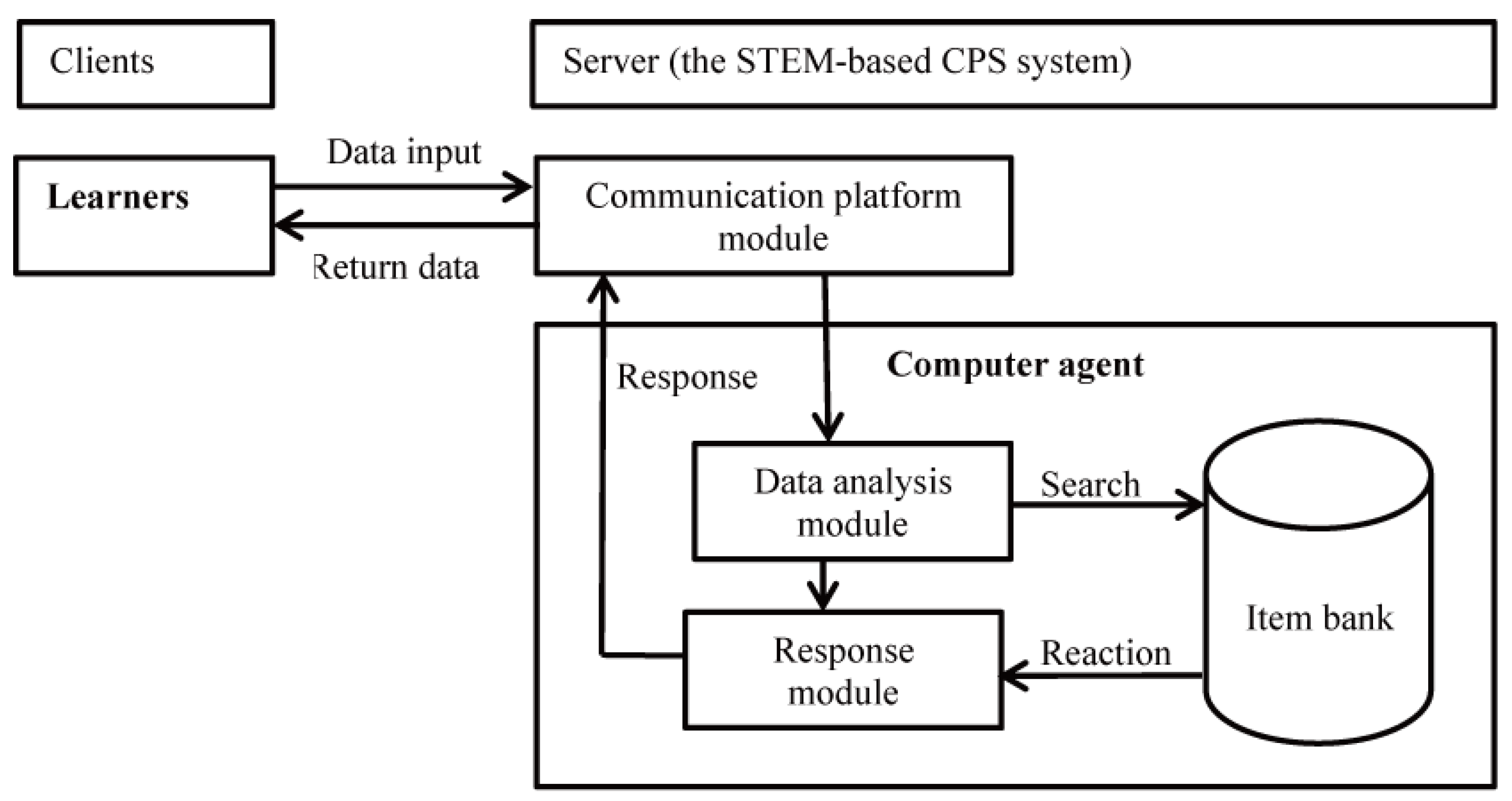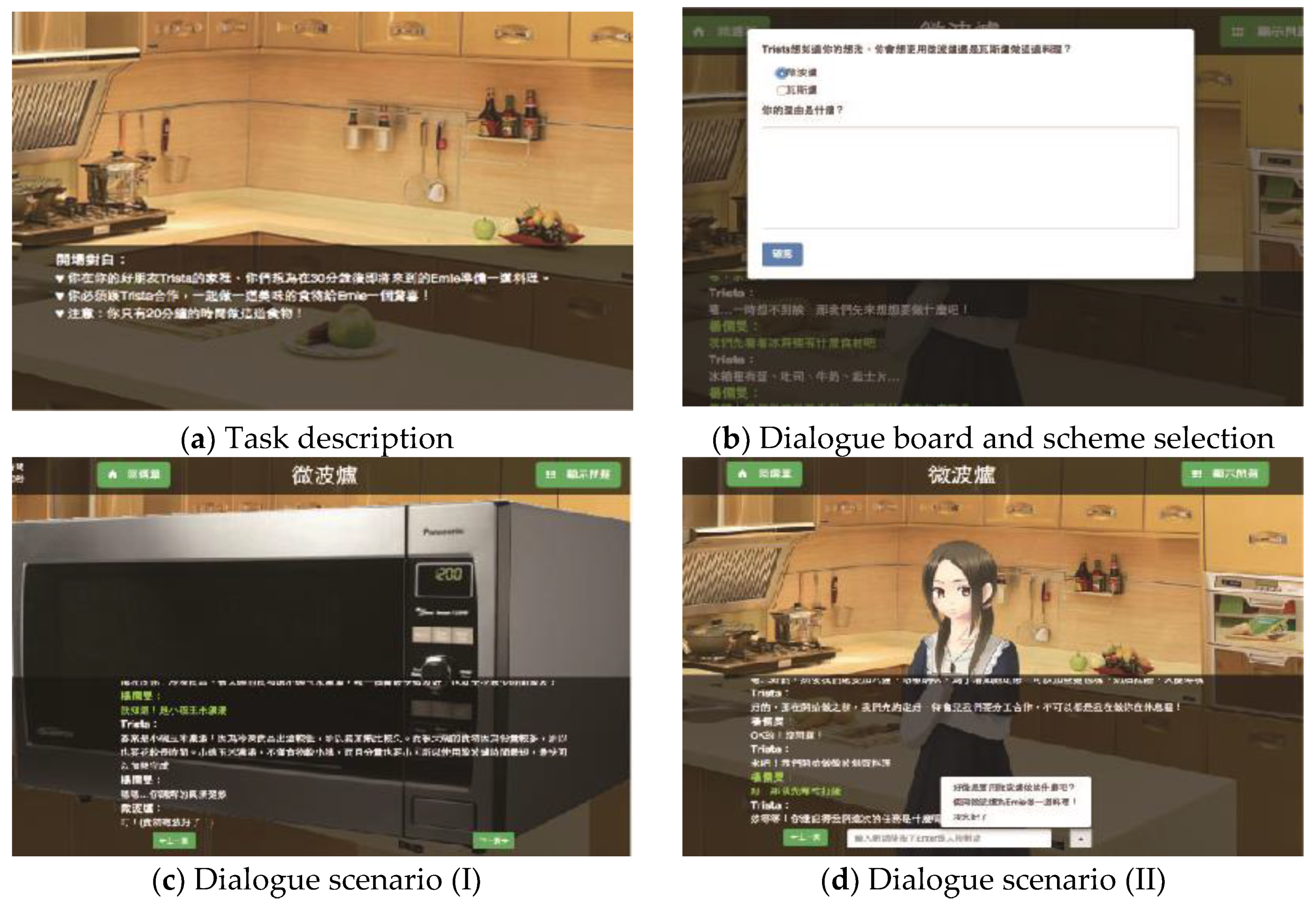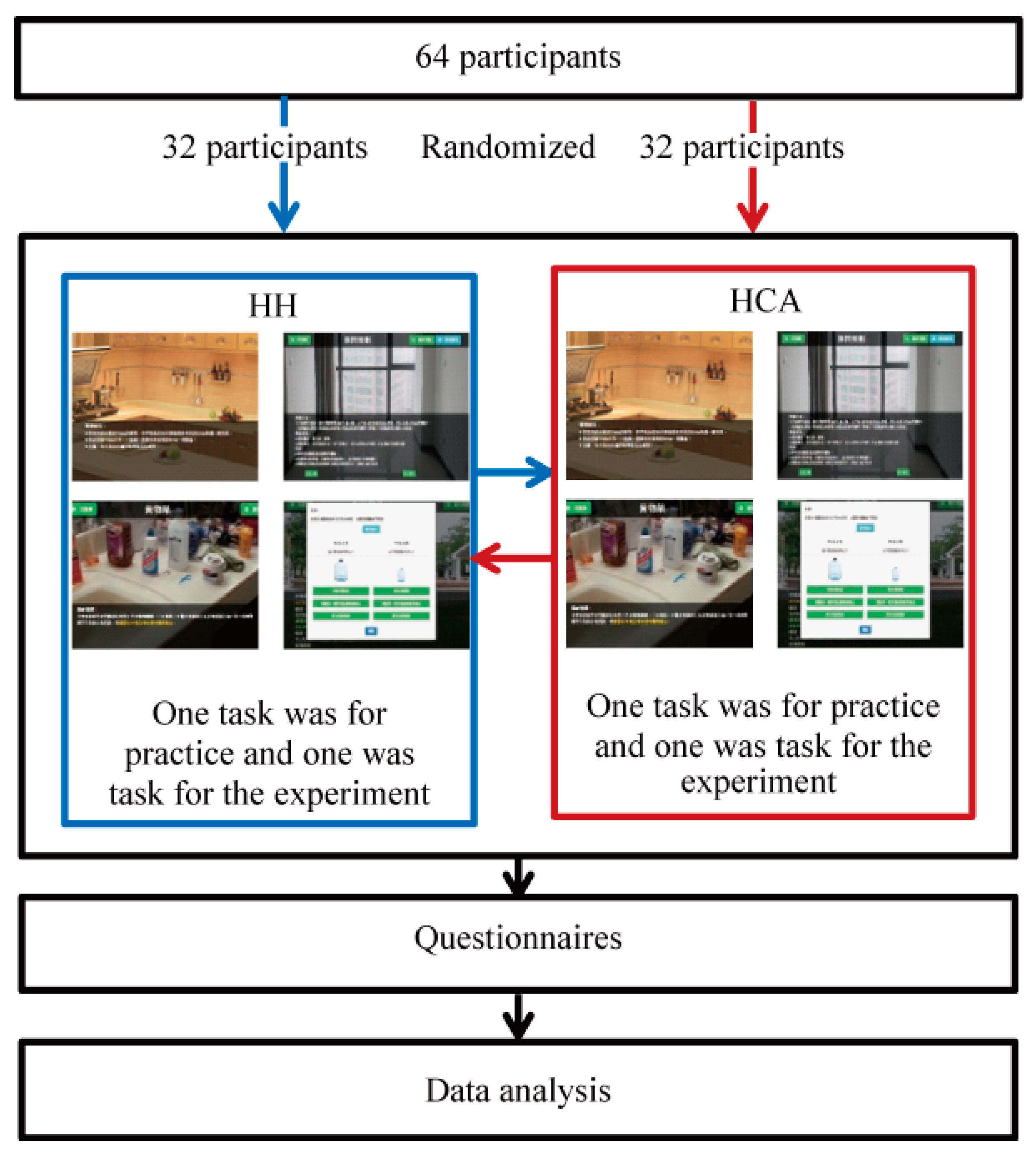Technology-Enhanced Learning: An Optimal CPS Learning Application
Abstract
1. Introduction
2. Methods
2.1. Participants and the CPS Learning Application
2.2. CPS Performance Scores
2.3. Materials
2.4. Design and Procedure
3. Results
3.1. CPS Performance
3.2. Program Performance Evaluation
4. Discussion and Conclusions
Funding
Conflicts of Interest
References
- Meadowcroft, J. Cooperative management regimes: Collaborative problem-solving to implement sustainable development. Int. Negotiat. 1999, 4, 225–254. [Google Scholar] [CrossRef]
- Shen, K.-Y.; Tzeng, G.-H. Advances in multiple criteria decision making for sustainability: Modeling and applications. Sustainability 2018, 10, 1600. [Google Scholar] [CrossRef]
- Straková, Z.; Cimermanová, I. Critical thinking development—A necessary step in higher education transformation towards sustainability. Sustainability 2018, 10, 3366. [Google Scholar] [CrossRef]
- Zhou, C.; Purushothaman, A.; Rongbutsri, N. Facilitating sustainability of education by problem-based learning (PBL) and information and communication technology (ICT). Int. J. Emerg. Technol. Learn. 2013, 8, 5. [Google Scholar] [CrossRef]
- Care, E.; Scoular, C.; Griffin, P. Assessment of collaborative problem solving in education environments. Appl. Meas. Educ. 2016, 29, 250–264. [Google Scholar] [CrossRef]
- Darling-Hammond, L. Policy frameworks for new assessments. In Assessment and Teaching of 21st Century Skills; Springer: Boston, MA, USA, 2012. [Google Scholar]
- Greiff, S.; Wüstenberg, S.; Molnár, G.; Fischer, A.; Funke, J.; Csapó, B. Complex problem solving in educational contexts—Something beyond g: Concept, assessment, measurement invariance, and construct validity. J. Educ. Psychol. 2013, 105, 364–379. [Google Scholar] [CrossRef]
- Barojas, J. Teacher training as collaborative problem solving. J. Educ. Technol. Soc. 2004, 7, 21–28. [Google Scholar]
- Lin, K.-Y.; Yu, K.-C.; Hsiao, H.-S.; Chu, Y.-H.; Chang, Y.-S.; Chien, Y.-H. Design of an assessment system for collaborative problem solving in STEM education. J. Comput. Educ. 2015, 2, 301–322. [Google Scholar] [CrossRef]
- Davies, A.; Fidler, D.; Gorbis, M. Future Work Skills 2020. Available online: http://www.iftf.org/uploads/media/SR1382A_UPRI_future_work_skills_sm.pdf (accessed on August 2019).
- Griffin, P.; Care, E. Assessment and Teaching of 21st Century Skills: Methods and Approach; Springer: Boston, MA, USA, 2014. [Google Scholar]
- Yu, K.-C.; Fan, S.-C.; Lin, K.-Y. Enhancing students’ problem-solving skills through context-based learning. Int. J. Sci. Math. Educ. 2015, 13, 1377–1401. [Google Scholar] [CrossRef]
- Alvarez, C.; Brown, C.; Nussbaum, M. Comparative study of netbooks and tablet PCs for fostering face-to-face collaborative learning. Comput. Hum. Behav. 2011, 27, 834–844. [Google Scholar] [CrossRef]
- Miller, D.; Averis, D.; Door, V. The interactive whiteboard: A literature survey. Technol. Pedagog. Educ. 2005, 14, 155–170. [Google Scholar]
- Nussbaum, M.; Alvarez, C.; McFarlane, A.; Gomez, F.; Claro, S.; Radovic, D. Technology as small group face-to-face Collaborative Scaffolding. Comput. Educ. 2009, 52, 147–153. [Google Scholar] [CrossRef]
- Scifres, E.L.; Gundersen, D.E.; Behara, R.S. An empirical investigation of electronic groups in the classroom. J. Educ. Bus. 1998, 73, 247–250. [Google Scholar] [CrossRef]
- Rosen, Y. Computer-based assessment of collaborative problem solving: Exploring the feasibility of human-to-agent approach. Int. J. Artif. Intell. Educ. 2015, 25, 380–406. [Google Scholar] [CrossRef]
- Azevedo, R.; Moos, D.C.; Johnson, A.M.; Chauncey, A.D. Measuring cognitive and metacognitive regulatory processes during hypermedia learning: Issues and challenges. Educ. Psychol. 2010, 45, 210–223. [Google Scholar] [CrossRef]
- Biswas, G.; Jeong, H.; Kinnebrew, J.S.; Sulcer, B.; Roscoe, R. Measuring self-regulated learning skills through social interactions in a teachable agent environment. Res. Pract. Technol. Enhanc. Learn. 2010, 5, 123–152. [Google Scholar] [CrossRef]
- Herborn, K.; Stadler, M.; Mustafić, M.; Greiff, S. The assessment of collaborative problem solving in PISA 2015: Can computer agents replace humans? Comput. Hum. Behav. 2018. [Google Scholar] [CrossRef]
- Veglis, A.; Maniou, T.A. Chatbots on the Rise: A New Narrative in Journalism. Stud. Media Commun. 2019, 7, 1–6. [Google Scholar] [CrossRef]
- Sancho, P.; Moreno-Ger, P.; Fuentes-Fernández, R.; Fernández-Manjón, B. Society, Adaptive role playing games: An immersive approach for problem based learning. J. Educ. Technol. Soc. 2009, 12, 110–124. [Google Scholar]
- Schwartz, D.L. The emergence of abstract representations in dyad problem solving. J. Learn. Sci. 1995, 4, 321–354. [Google Scholar] [CrossRef]
- Ding, N.; Harskamp, E. How partner gender influences female students’ problem solving in physics education. J. Sci. Educ. Technol. 2006, 15, 331–343. [Google Scholar] [CrossRef]
- Yağcı, M. Web-mediated problem-based learning and computer programming: Effects of study approach on academic achievement and attitude. J. Educ. Comput. Res. 2018, 56, 272–292. [Google Scholar] [CrossRef]
- Balakrishnan, B. Online computer supported collaborative learning (CSCL) for engineering students: A case study in malaysia. Comput. Appl. Eng. Educ. 2015, 23, 352–362. [Google Scholar] [CrossRef]
- Ross, J.L.; Drysdale, M.T.B.; Schulz, R.A. Cognitive learning styles and academic performance in two postsecondary computer application cCourses. J. Res. Comput. Educ. 2001, 33, 400–412. [Google Scholar] [CrossRef]
- Lee, S.Y.; Kim, J.H.; Geum, C.R.; Wu, S.J.; Kim, J.S.; Kim, J.S. Effects of personality traits on collaborative performance in problem-based learning tutorials. Saudi Med. J. 2017, 38, 1062–1063. [Google Scholar] [CrossRef] [PubMed]
- Margrett, J.A.; Marsiske, M. Gender differences in older adults’ everyday cognitive collaboration. Int. J. Behav. Dev. 2002, 26, 45–59. [Google Scholar] [CrossRef]
- Miller, P.H. Gender and information technology: Perspectives from human cognitive development. Front. A J. Women Stud. 2005, 26, 148–167. [Google Scholar] [CrossRef]
- Asterhan, C.S.C.; Schwarz, B.B.; Gil, J. Small-group, computer-mediated argumentation in middle-school classrooms: The effects of gender and different types of online teacher guidance. Br. J. Educ. Psychol. 2012, 82, 375–397. [Google Scholar] [CrossRef]
- Eisenhart, M. Talking about leaving: Why undergraduates leave the sciences. Am. Sci. 1998, 86, 395. [Google Scholar]
- Prinsen, F.R.; Volman, M.L.; Terwel, J. Gender-related differences in computer-mediated communication and computer-supported collaborative learning. J. Comput. Assist. Learn. 2007, 23, 393–409. [Google Scholar] [CrossRef]
- Papastergiou, M. Digital Game-Based Learning in high school Computer Science education: Impact on educational effectiveness and student motivation. Comput. Educ. 2009, 52, 1–12. [Google Scholar] [CrossRef]
- Lin, C.F.; Hung, Y.H.; Chang, R.I.; Hung, S.H. Developing a problem-solving learning system to assess the effects of different materials on learning performance and attitudes. Comput. Educ. 2014, 77, 50–66. [Google Scholar] [CrossRef]
- Li, Q. Gender and computer-mediated communication: An exploration of elementary students’ mathematics and science learning. J. Comput. Math. Sci. Teach. 2002, 21, 341–359. [Google Scholar]
- Klašnja-Milićević, A.; Vesin, B.; Ivanović, M.; Budimac, Z. E-Learning personalization based on hybrid recommendation strategy and learning style identification. Comput. Educ. 2011, 56, 885–899. [Google Scholar] [CrossRef]
- Diaz, D.P.; Cartnal, R. Students’ learning styles in two classes: Online distance learning and equivalent on-campus. Coll. Teach. 1999, 47, 130–135. [Google Scholar] [CrossRef]
- Graf, S.; Viola, S.R.; Leo, T.; Kinshuk. In-depth analysis of the Felder-Silverman learning style dimensions. J. Res. Technol. Educ. 2007, 40, 79–93. [Google Scholar] [CrossRef]
- Felder, R.M.; Silverman, L.K. Learning and teaching styles in engineering education. Eng. Educ. 1988, 78, 674–681. [Google Scholar]
- Carver, C.A.; Howard, R.A.; Lane, W.D. Enhancing student learning through hypermedia courseware and incorporation of student learning styles. IEEE Trans. Educ. 1999, 42, 33–38. [Google Scholar] [CrossRef]
- Kuo, B.C. Teachers’ Collaborative Problem Solving Teaching Competency Project. Available online: https://sites.google.com/site/cpswebsite2014 (accessed on August 2019).
- Greiff, S.; Kretzschmar, A.; Müller, J.C.; Spinath, B.; Martin, R. The computer-based assessment of complex problem solving and how it is influenced by students’ information and communication technology literacy. J. Educ. Psychol. 2014, 106, 666–680. [Google Scholar] [CrossRef]
- Delone, W.H.; McLean, E. The DeLone and McLean model of information systems success: A ten-year update. J. Manag. Inf. Syst. 2003, 19, 9–30. [Google Scholar]



| Variable. | Description | Type |
|---|---|---|
| ID | Sample (N = 64) | Number |
| Age | 18–22 years old (M = 20.13, SD = 1.18) | Number |
| Gender | Male (N = 36) Female (N = 28) | Category |
| Learning style | Four pairs of extremes of learning style preferences were evaluated: Active/reflective, sensing/intuitive, visual/verbal, and sequential/global | Category |
| Level of learning style | High (top 50%) Low (bottom 50%) | Category |
| Collaborative Interaction (CI) | HH (human–human interaction) HCA (human–computer agent interaction) | Category |
| Problem scenario | Scenario 1: Using a microwave Scenario 2: Placing water Scenario 3: Fastening shelves Scenario 4: Organizing a bedroom | Category |
| Trial | 128 trials (each student participated in one HH trial and one HCA trial) | Number |
| CPS performance | CPS performance was scored (1–100%) | Number |
| Application evaluation | A nine-item questionnaire with a four-point Likert-type scale (“strongly agree” (1 point) to “strongly disagree” (4 points)) | Number |
| HH | HCA | |||
|---|---|---|---|---|
| % | SD | % | SD | |
| Gender | ||||
| Male | 78.56 | 6.86 | 81.44 | 8.90 |
| Female | 76.71 | 3.30 | 76.29 | 8.12 |
| Learning style | ||||
| Sensing | 78.17 | 5.01 | 79.17 | 6.30 |
| Intuitive | 76.83 | 6.31 | 80.00 | 12.20 |
| Visual | 77.75 | 6.52 | 77.83 | 8.86 |
| Verbal | 78.67 | 2.74 | 85.67 | 8.96 |
| Sequential | 78.13 | 5.71 | 74.25 | 5.12 |
| Global | 77.38 | 5.61 | 84.13 | 9.15 |
| Active | 79.00 | 6.62 | 76.61 | 8.35 |
| Reflective | 76.00 | 3.40 | 82.00 | 9.08 |
| Total | 77.8 | 5.6 | 79.2 | 8.9 |
| Source | Type III Sum of Squares | Mean Square | F | p | partial η2 |
|---|---|---|---|---|---|
| Collaborative Interaction (CI) | 321.22 | 321.22 | 24.49 | <0.01 | 0.31 |
| CI × Gender | 32.60 | 32.60 | 2.49 | 0.12 | 0.04 |
| CI × Sensing/Intuitive | 20.00 | 20.00 | 1.53 | 0.22 | 0.03 |
| CI × Visual/Verbal | 112.50 | 112.50 | 8.58 | <0.01 | 0.14 |
| CI × Sequential/Global | 100.00 | 100.00 | 7.62 | <0.01 | 0.12 |
| CI × Active/Reflective | 75.00 | 75.00 | 5.72 | 0.02 | 0.10 |
| HH | HCA | t-test | ||||
|---|---|---|---|---|---|---|
| M | SD | M | SD | t | p | |
| Service quality | 3.28 | 0.44 | 3.03 | 0.58 | 3.24 | <0.01 |
| Program quality | 3.06 | 0.36 | 2.88 | 0.50 | 2.98 | <0.01 |
| User satisfaction | 3.13 | 0.60 | 2.88 | 0.49 | 3.55 | <0.01 |
| Program use | 3.13 | 0.70 | 2.88 | 0.70 | 3.00 | <0.01 |
| Net benefits | 3.25 | 0.56 | 3.00 | 0.62 | 2.65 | <0.01 |
| Information quality | 3.31 | 0.59 | 3.00 | 0.36 | 5.35 | <0.01 |
| Total | 3.15 | 0.37 | 2.97 | 0.43 | 3.75 | <0.01 |
© 2019 by the author. Licensee MDPI, Basel, Switzerland. This article is an open access article distributed under the terms and conditions of the Creative Commons Attribution (CC BY) license (http://creativecommons.org/licenses/by/4.0/).
Share and Cite
Chien, Y.-H. Technology-Enhanced Learning: An Optimal CPS Learning Application. Sustainability 2019, 11, 4415. https://doi.org/10.3390/su11164415
Chien Y-H. Technology-Enhanced Learning: An Optimal CPS Learning Application. Sustainability. 2019; 11(16):4415. https://doi.org/10.3390/su11164415
Chicago/Turabian StyleChien, Yu-Hung. 2019. "Technology-Enhanced Learning: An Optimal CPS Learning Application" Sustainability 11, no. 16: 4415. https://doi.org/10.3390/su11164415
APA StyleChien, Y.-H. (2019). Technology-Enhanced Learning: An Optimal CPS Learning Application. Sustainability, 11(16), 4415. https://doi.org/10.3390/su11164415





